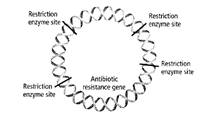
Concept explainers
Introduction:
Researchers use genetic engineering to manipulate DNA. It makes production of organisms that contain individual genes from another organism possible. Recombinant DNA contains DNA from different sources. It can be made by connecting fragments of DNA from different sources. DNA ligase is used to join a plasmid DNA and a DNA fragment obtained from another genome to create a recombinant plasmid DNA.
Answer to Problem 14A
Correct answer :
The correct answer is option A. to carry the foreign DNA into the host cell
Explanation of Solution
Explanation/justification for the correct answer:
Option A. to carry the foreign DNA into the host cell- The illustration given below shows a recombinant plasmid. Foreign DNA containing the gene for antibiotic resistance is inserted into the plasmid vector. The recombinant plasmid then carries the foreign DNA into the host bacterial cell where it replicates independently of the bacterial chromosome. Millions of bacteria are produced containing the recombinant DNA molecules. These are called gene clones. This technique is used in gene cloning. Hence this is the correct option.

Explanation for incorrect answer:
Option B. to identify the source of DNA as foreign- The given illustration shows a recombinant plasmid. Foreign DNA containing the gene for antibiotic resistance is inserted into the plasmid vector. The recombinant plasmid then carries the foreign DNA into the host bacterial cell. It does not identify the source of DNA as foreign. Hence, this is not the correct option.
Option C. to identify the host cell that has taken up the gene of interest- The given illustration shows a recombinant plasmid. Foreign DNA containing the gene for antibiotic resistance is inserted into the plasmid vector. The recombinant plasmid then carries the foreign DNA into the host bacterial cell. It does not identify the host cell that has taken up the gene of interest.
Hence, this is not the correct option.
Option D. make the foreign DNA susceptible to digestion with enzymes- The given illustration shows a recombinant plasmid. Foreign DNA containing the gene for antibiotic resistance is inserted into the plasmid vector. The recombinant plasmid then carries the foreign DNA into the host bacterial cell. It does not make the foreign DNA susceptible to digestion with enzymes. Hence, this is not the correct option.
Chapter 13 Solutions
Biology Illinois Edition (Glencoe Science)
Additional Science Textbook Solutions
Genetic Analysis: An Integrated Approach (2nd Edition)
Human Physiology: An Integrated Approach (8th Edition)
Essentials of Genetics (9th Edition) - Standalone book
Biological Science
Human Biology: Concepts and Current Issues
 Human Anatomy & Physiology (11th Edition)BiologyISBN:9780134580999Author:Elaine N. Marieb, Katja N. HoehnPublisher:PEARSON
Human Anatomy & Physiology (11th Edition)BiologyISBN:9780134580999Author:Elaine N. Marieb, Katja N. HoehnPublisher:PEARSON Biology 2eBiologyISBN:9781947172517Author:Matthew Douglas, Jung Choi, Mary Ann ClarkPublisher:OpenStax
Biology 2eBiologyISBN:9781947172517Author:Matthew Douglas, Jung Choi, Mary Ann ClarkPublisher:OpenStax Anatomy & PhysiologyBiologyISBN:9781259398629Author:McKinley, Michael P., O'loughlin, Valerie Dean, Bidle, Theresa StouterPublisher:Mcgraw Hill Education,
Anatomy & PhysiologyBiologyISBN:9781259398629Author:McKinley, Michael P., O'loughlin, Valerie Dean, Bidle, Theresa StouterPublisher:Mcgraw Hill Education, Molecular Biology of the Cell (Sixth Edition)BiologyISBN:9780815344322Author:Bruce Alberts, Alexander D. Johnson, Julian Lewis, David Morgan, Martin Raff, Keith Roberts, Peter WalterPublisher:W. W. Norton & Company
Molecular Biology of the Cell (Sixth Edition)BiologyISBN:9780815344322Author:Bruce Alberts, Alexander D. Johnson, Julian Lewis, David Morgan, Martin Raff, Keith Roberts, Peter WalterPublisher:W. W. Norton & Company Laboratory Manual For Human Anatomy & PhysiologyBiologyISBN:9781260159363Author:Martin, Terry R., Prentice-craver, CynthiaPublisher:McGraw-Hill Publishing Co.
Laboratory Manual For Human Anatomy & PhysiologyBiologyISBN:9781260159363Author:Martin, Terry R., Prentice-craver, CynthiaPublisher:McGraw-Hill Publishing Co. Inquiry Into Life (16th Edition)BiologyISBN:9781260231700Author:Sylvia S. Mader, Michael WindelspechtPublisher:McGraw Hill Education
Inquiry Into Life (16th Edition)BiologyISBN:9781260231700Author:Sylvia S. Mader, Michael WindelspechtPublisher:McGraw Hill Education





